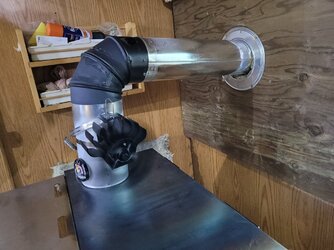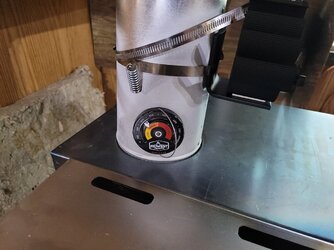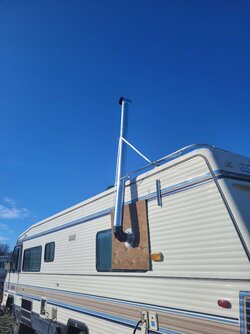I have a different then normal setup. Went out the window instead of the roof. There is a 5.2 degree down angle to the pipe here so rain stays outside. Smoke is leaking out of the damper. I had it running at 600 for 45 minutes and still had no change in draft.
The damper sleeve goes about an inch below the inside roof of the stove.
I have not finished the stove piping outside, it is just sitting open at this time.
Almost forgot, this picture was taken as she was cooling off.
Ps I just installed this and honestly have near no idea what I am doing. I thought "get it hot enough and the draft would take care of the smoke." Maybe the down angle on the pipe is messing that up? Maybe the insert going so far into the stove is messing it up? Maybe I just need to finish putting the outside pipe together? Any thoughts before I smoke myself out! Lol


The damper sleeve goes about an inch below the inside roof of the stove.
I have not finished the stove piping outside, it is just sitting open at this time.
Almost forgot, this picture was taken as she was cooling off.
Ps I just installed this and honestly have near no idea what I am doing. I thought "get it hot enough and the draft would take care of the smoke." Maybe the down angle on the pipe is messing that up? Maybe the insert going so far into the stove is messing it up? Maybe I just need to finish putting the outside pipe together? Any thoughts before I smoke myself out! Lol





 It would have helped to note from the beginning that this is setup in an RV. Single-wall galvanized is neither safe nor proper. Nor is the pass-through on plywood. That should be metal at least. I hope the stove is at least bolted down. The stove clearances should be 36" or 12" with proper, ventilated wall shielding. A wad of insulation doesn't make it safe.
It would have helped to note from the beginning that this is setup in an RV. Single-wall galvanized is neither safe nor proper. Nor is the pass-through on plywood. That should be metal at least. I hope the stove is at least bolted down. The stove clearances should be 36" or 12" with proper, ventilated wall shielding. A wad of insulation doesn't make it safe.